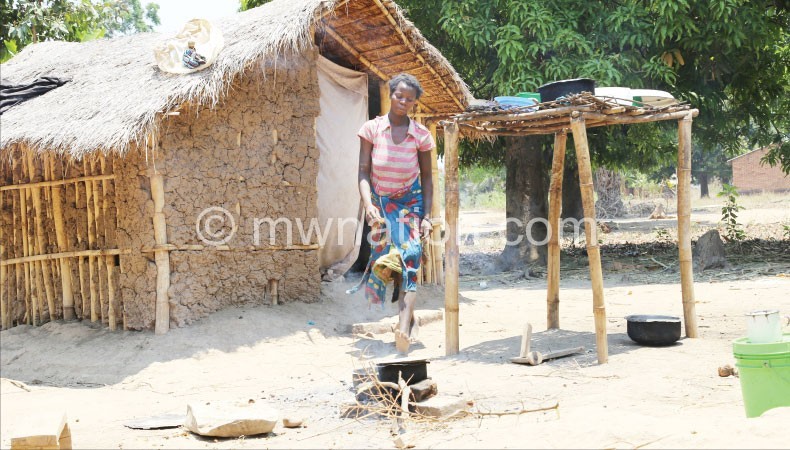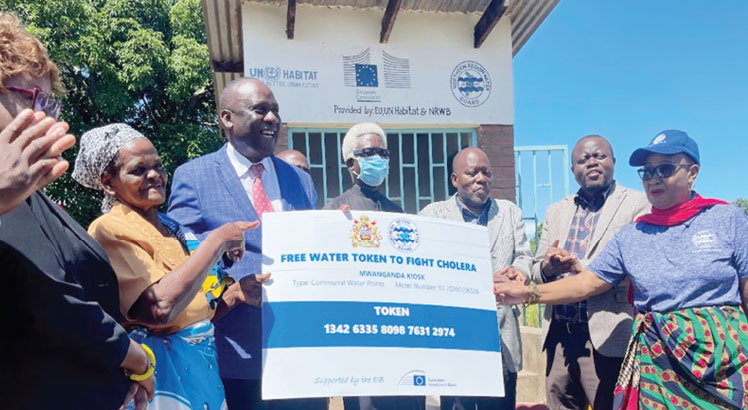Survivors saving for next flood

Some Karonga residents are making hay while the sun shines, pooling their savings in anticipation for ruinous effects in the fast-approaching rainy season. JAMES CHAVULA writes.
At the climax of summer, faces of disasters that ravaged the shoreline of Karonga in previous years are unmistakable.
On a sunny day, the footprints of the perennial phenomenon flash past. A top-bottom crack on the wall of earthquake-hit St Mary’s Catholic Church as well as extensive waterways excavated to act as sinks for ferocious water flooding from bursting rivers with disappearing courses.
However, nothing mirrors Karonga North’s vulnerability than the remains of a thatched mud hut Stanesi Kalua and Charles Kalongolera once called their home.
In Mwantende Village, their two-bedroomed house stands aloft with crudely demolished walls as a reminder of how flooding Mponda stream bared its ferocity in April this year.
In the scorching heat, Kalua, a mother of four, recalled with tears how waters swept past—going away with plates, chickens, clothes, blankets, foodstuffs and other valuable possession in the wee hours of that fateful day.
“It rained without end,” she says. “Around 4 am, my husband and I were dead asleep when we heard the children’s cry for help. In no time, the world around was crumbling.”
The collapsed world sprawls beyond the hit walls of the house yet to be re-built. Her neighbours recall the village was soaked by a tide raging hip-high and nearly 10 houses fell to pieces.
The youthful couple is still struggling to construct a new house. They have no bank account. No savings. Their life has always been hand-to-mouth, for rice, maize and cassava fields produce just enough for subsistence.
They now live in a one-roomed shack with their four children.
During the visit, she was seen emerging from the new hut with a bent back, carrying a basket of foodstuffs for the day.
She explained: “We have moulded 4 500 bricks, bought 2 500 more and collected grass for roofing, but our family is still living like refugees since we cannot afford a builder.”
Just like that, her household offers those looking for tales of disaster preparedness a memorable example of what not to do when living in an area beset by floods almost every year.
By contrast, Danifold Mwakapala and his wife— parents of three whose two-bedroom house fell apart during the tragedy— were able to re-build their home because they belong to a group where villagers put together their savings and give each other low-interest loans as well as relief funds for disaster response.
“When my house was flooded, I only had to explain my predicament to the group and they authorised money for me immediately,” says Mwakapala.
There are four savings and internal lending communities (Silc) in Kalua’s Village alone and about 20 in neighbouring Chiwowola.
Brought together by agents trained by the Catholic Development Commission (Cadecom), Silc group members have accepted that disasters are bound to happen when least expected. They put together their savings, lend each other for business growth and set aside funds for difficult times.
One of the agents, McBen Mkandawire, says Silc is becoming widespread because people are tired of being interrupted by floods.
“Since last year, I have helped over 20 groups,” said the man, weaned by Cadecom in April, thereby getting the liberty of visiting other villages to establish banking groups at a commercial fee.
He counts among his brainchildren the star performing Tafikapo group, which shared K956 000 last year—with top-earners taking home K54 000 and the lowest K20 000.
“For us, the name ‘Tafikapo’ means a realisation that floods are a perennial disaster whose impact we can mitigate if united,” says Village Head Mwakyusa.
He says everybody takes part in discussions and nobody saves more than K1 000 per week.
“Actually, we agreed one can only buy up to five shares worth K200 each because we do not want those who save more to hijack the groups,” he says.
The Silc approach largely borrows from the widespread notion of village savings and lending groups, popularly known as mabanki a m’mudzi or village banks.
The units run two funds, beneficiaries say.
First, there is a social fund for emergencies and weekly savings which determine dividends members take home after nine months. This also gives the community members an opportunity to acquire low-interest loans for business and disaster response as well.
Locals feel banks are not accessible to the disaster hit who have to travel about 30 km to Karonga Boma where they are required to fill stacks of forms and declare assets as surety.
Flood survivors often have neither time nor assets for collateral. Their goods and energy go with the roaring water.
The majority of areas in Karonga North lie in the paths for water speeding into Lake Malawi. These include such rivers as Kyungu, Songwe, Ntakisha, Kakolya, Kasanga and Ngalamu.
Save for the clash of raging rivers, there are sunny days when the low-lying stretch is flooded by water gushing from the highlands of Ngana, Chisi and Iyembe.
Franklin Msiska, desk officer for Cadecom in Karonga Diocese, says the savings are one of the numerous efforts to reduce the impact of disasters on low-income households.
In Chiwowola, Ibrahim Phiri has bought a bicycle and a goat from Silc and his wealth is multiplying.
Likewise, Pearson Mvula, who could not afford a chicken, now has two goats.n





